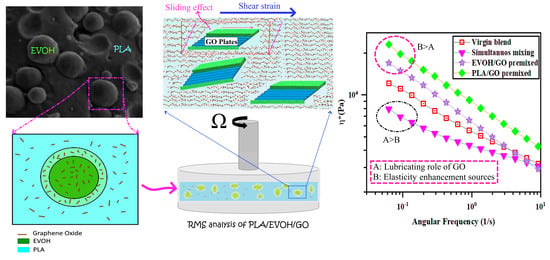Effect of Graphene Oxide Localization on Morphology Development and Rheological and Mechanical Properties of Poly(lactic acid)/ethylene vinyl Alcohol Copolymer Blend Composites: A Comprehensive Study
Abstract
:1. Introduction
2. Materials and Method
2.1. Materials
2.2. GO Nanoplatelets Synthesis
2.3. Processing of PLA/EVOH/GO Composites
2.4. Characterization Methods
3. Result and Discussion
3.1. Characterization of Synthesized GO
3.2. GO Localization in PLA/EVOH/GO Composite
3.3. Morphological Evaluation
- Droplet radius reduction, which was observed when the GO content increased from 0.5 wt% to 1 wt%, was a consequence of the migration of the GO particles to the PLA and the interface of PLA/EVOH. Increasing the amount of the GO particles can compete kinetically with the thermodynamic affinity of the GO to EVOH droplets, thereby increasing the possibility of localizing GO in other phases (PLA and the interface) besides EVOH. Particle localization in PLA and the interface was an important factor in decreasing the size of the EVOH droplets due to the decrease in the coalescence rate of the EVOH droplets [35].
- When the GO content was increased from 0.25 wt% to 0.5 wt%, the size of EVOH droplets increased. The localization of GO in PLA and at the interface was insufficient for controlling the coalescence and breakup of droplets compared to the GO distributed in EVOH.
- According to Table 4, when the GO nanoparticles were premixed with EVOH, the EVOH droplet radius increased from 1.01 to 3.13 µm. This increment is attributed to the predominant localization of GO in EVOH due to premixing with EVOH, which reduced the breakup rate of droplets.
- When GO was premixed with PLA, the radius decreased to 0.94 µm. The decrease in droplet radius for the sample (PLA/0.25GO)/EVOH could be attributed to the mixing protocol used, where PLA was first mixed with GO before EVOH was added to the PLA/GO blend. The migration of GO from PLA to EVOH during mixing could be explained by the higher affinity of GO to EVOH. Subsequently, the GO particles became trapped at the interface of the PLA/EVOH blend, causing a reduction in the interfacial tension between the two phases. The obtained results demonstrate that the mixing protocol used had a notable impact on the morphology and size of dispersed droplets in blend composites.
3.4. Rheological Assessments
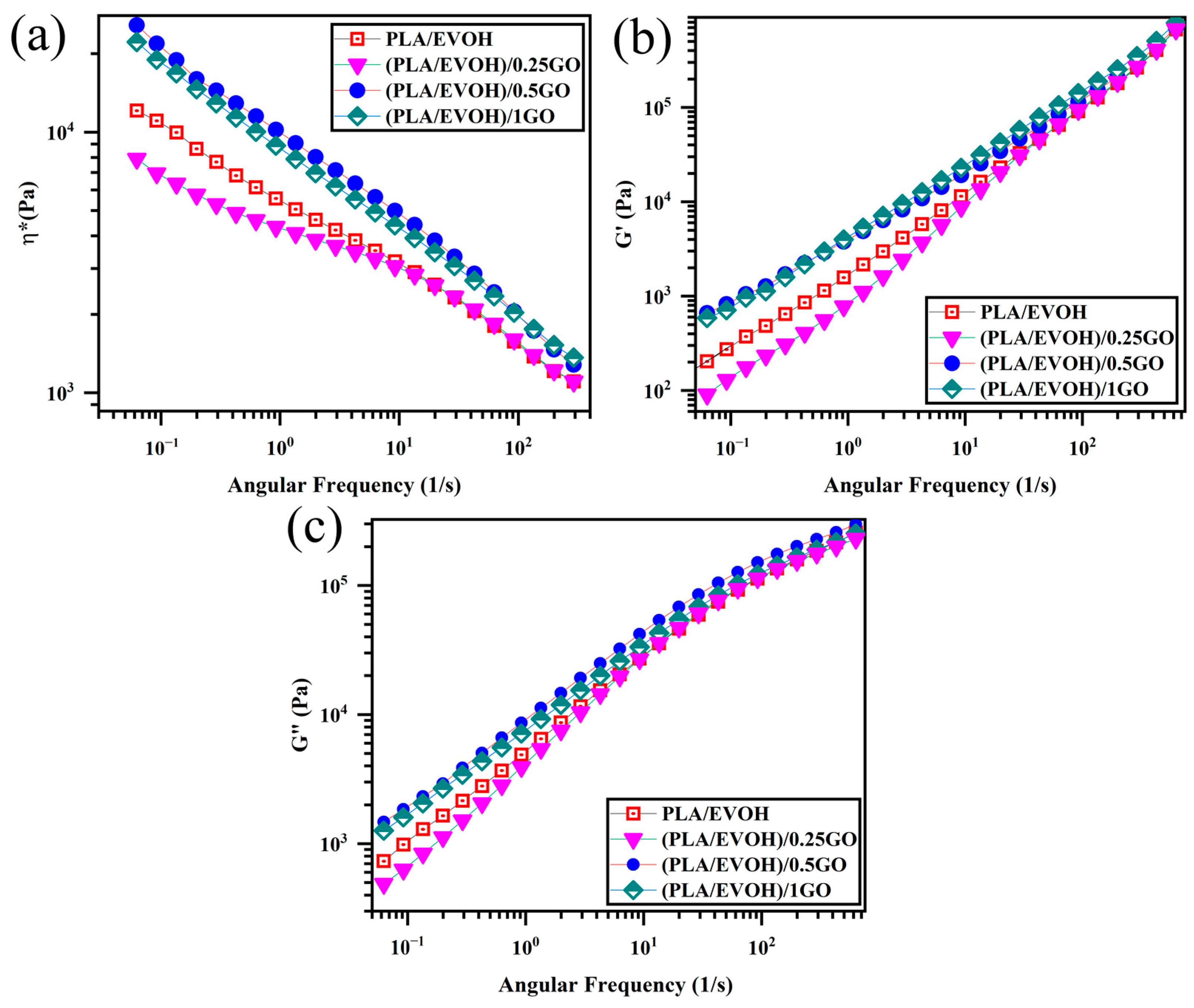

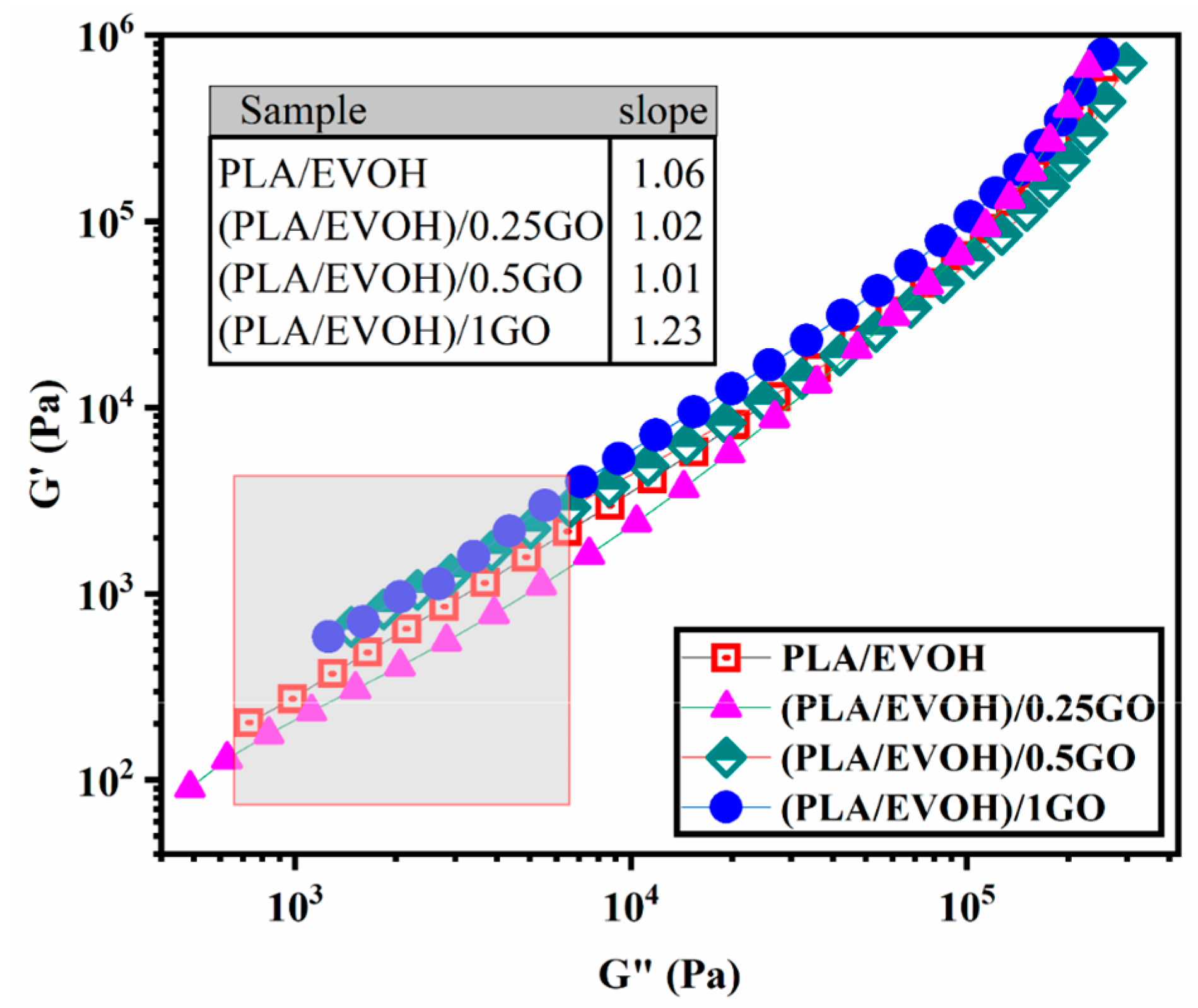
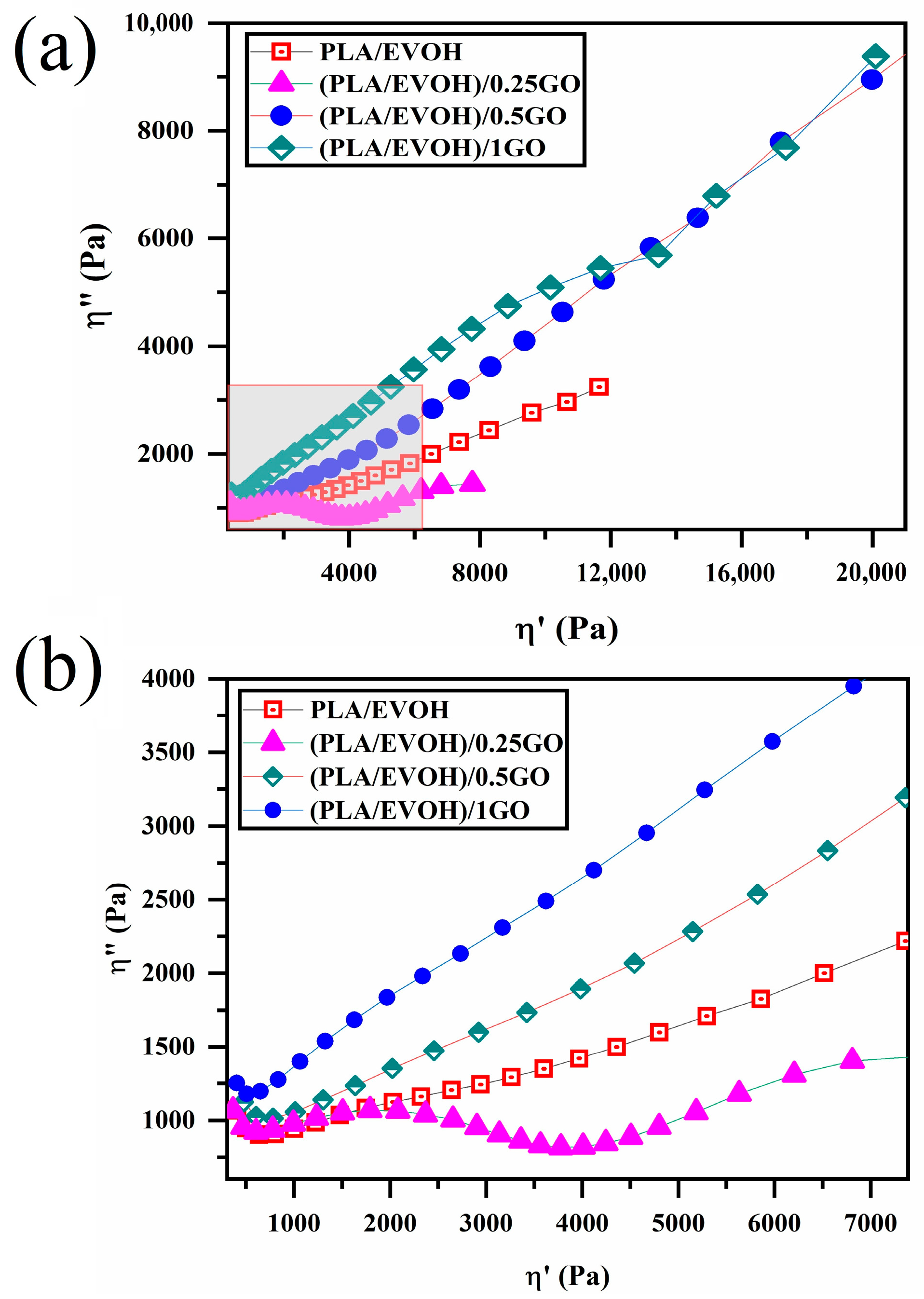
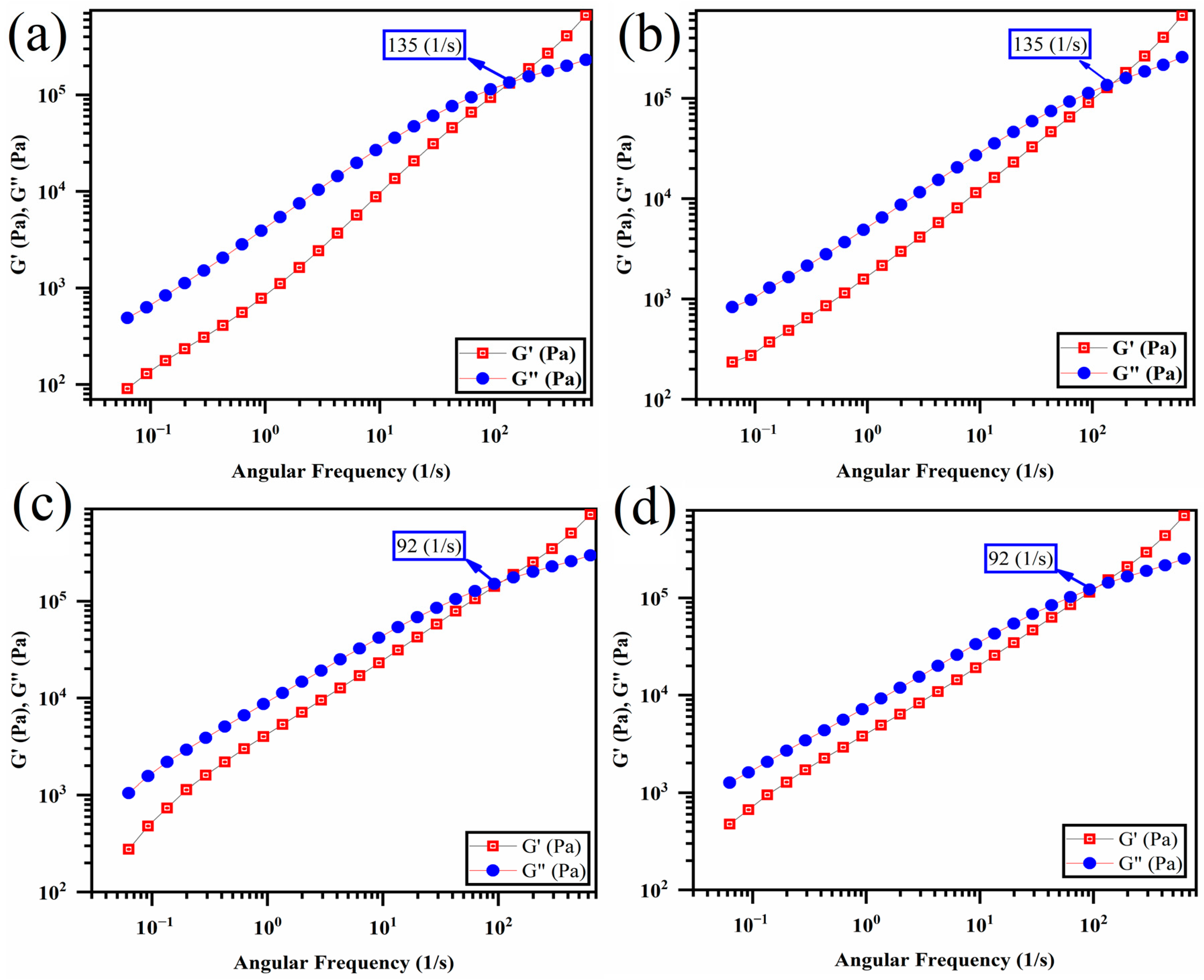
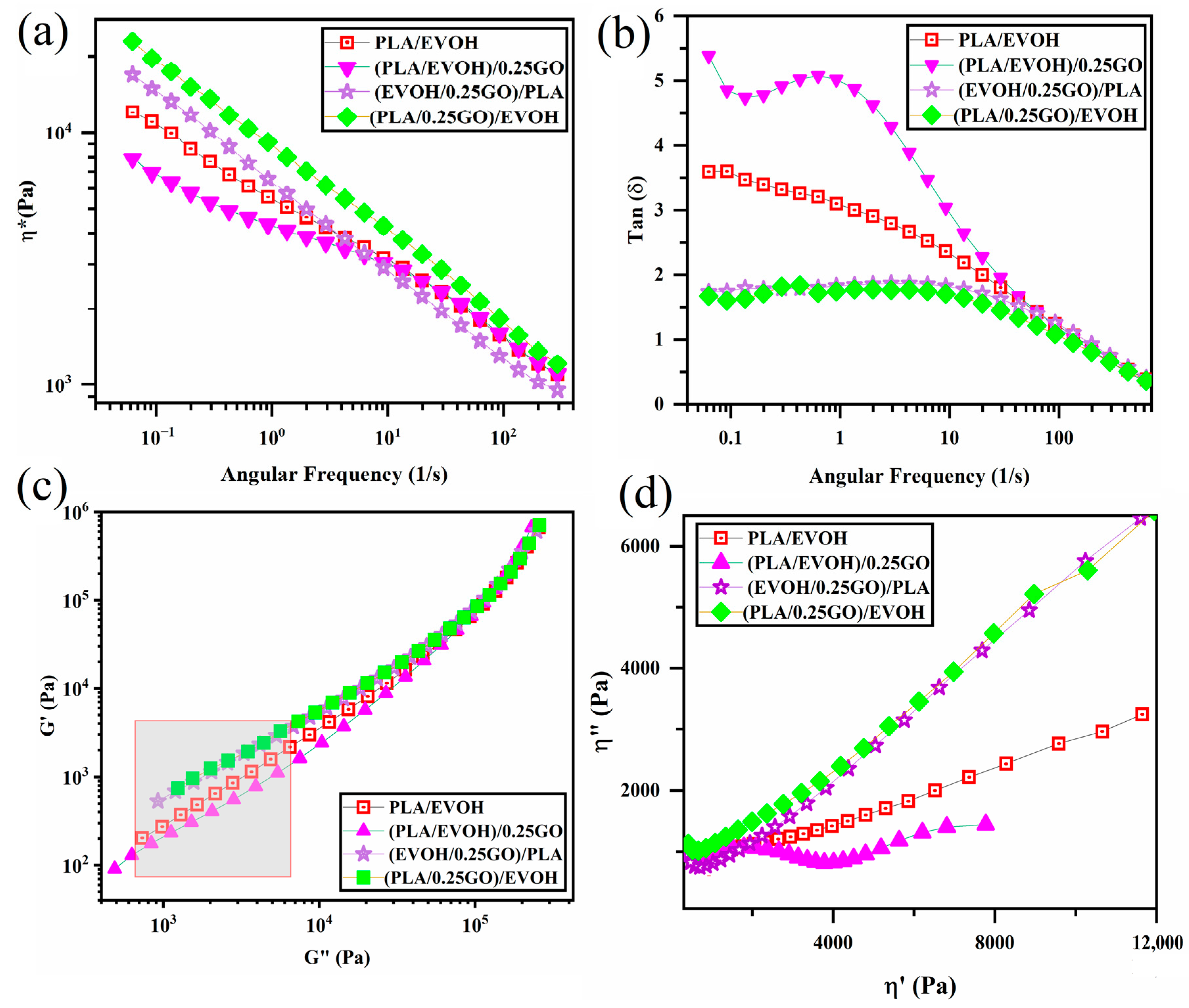
3.5. Rheological Model
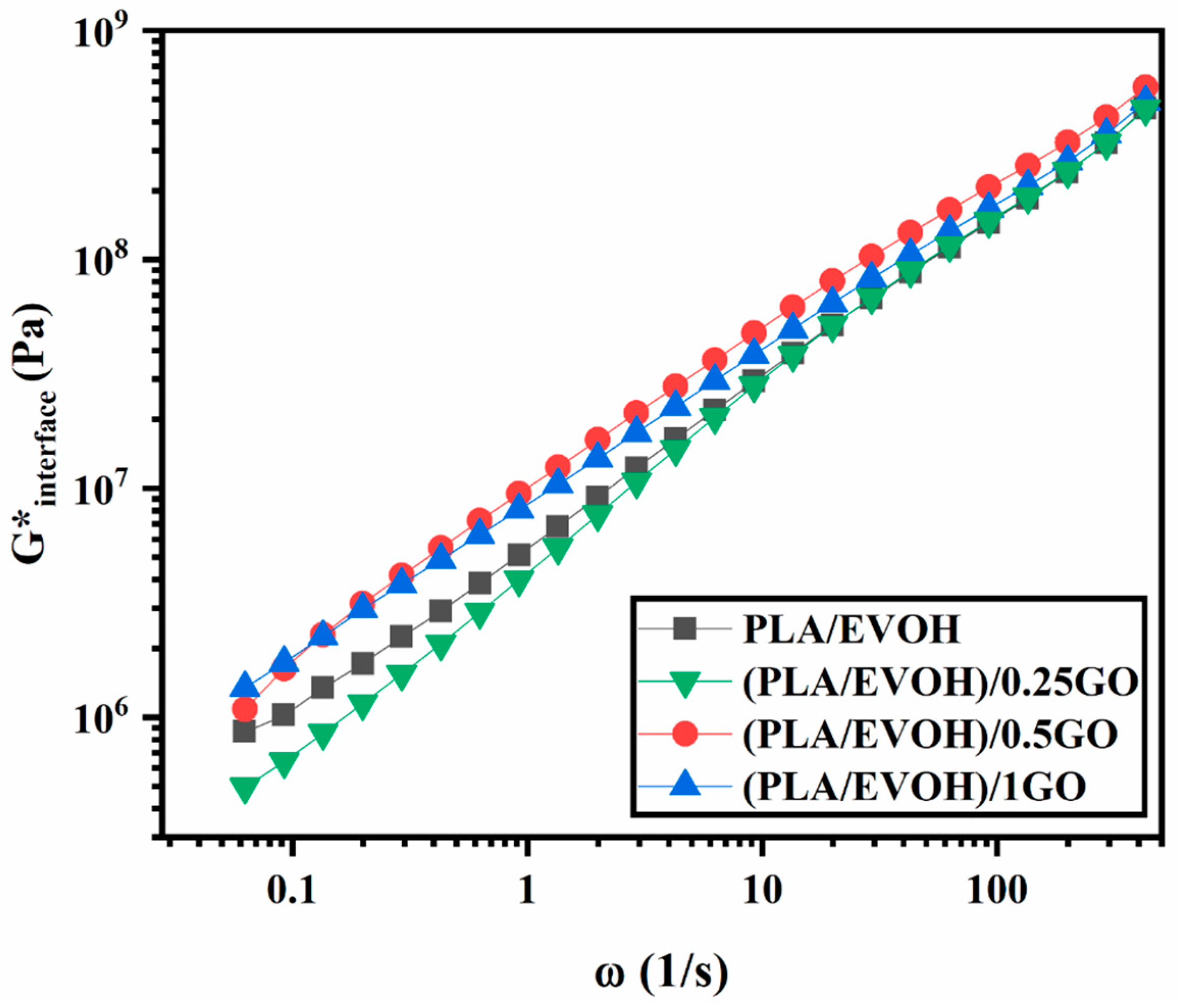
3.6. Mechanical Properties
4. Conclusions
Author Contributions
Funding
Data Availability Statement
Conflicts of Interest
References
- Swetha, T.A.; Bora, A.; Mohanrasu, K.; Balaji, P.; Raja, R.; Ponnuchamy, K.; Muthusamy, G.; Arun, A. A comprehensive review on polylactic acid (PLA)–Synthesis, processing and application in food packaging. Int. J. Biol. Macromol. 2023, 234, 123715. [Google Scholar] [CrossRef] [PubMed]
- Nirmal Kumar, K.; Dinesh Babu, P.; Surakasi, R.; Kumar, P.M.; Ashokkumar, P.; Khan, R.; Alfozan, A.; Gebreyohannes, D.T. Mechanical and thermal properties of bamboo fiber–reinforced PLA polymer composites: A critical study. Int. J. Polym. Sci. 2022, 2022, 1332157. [Google Scholar] [CrossRef]
- Ebrahimi, F.; Ramezani Dana, H. Poly lactic acid (PLA) polymers: From properties to biomedical applications. Int. J. Polym. Mater. Polym. Biomater. 2022, 71, 1117–1130. [Google Scholar] [CrossRef]
- Park, Y.; Lee, J. Comparison of Recently Developed Toughening Strategies for Polylactic Acid Blends. J. Ind. Eng. Chem. 2023, 125, 50–57. [Google Scholar] [CrossRef]
- Fortelny, I.; Ujcic, A.; Fambri, L.; Slouf, M. Phase Structure, Compatibility, and Toughness of PLA/PCL Blends: A Review. Front. Mater. 2019, 6, 206. [Google Scholar] [CrossRef]
- Chen, X.; Zeng, Z.; Ju, Y.; Zhou, M.; Bai, H.; Fu, Q. Design of biodegradable PLA/PBAT blends with balanced toughness and strength via interfacial compatibilization and dynamic vulcanization. Polymer 2023, 266, 125620. [Google Scholar] [CrossRef]
- Shi, K.; Liu, G.; Sun, H.; Yang, B.; Weng, Y. Grafting Polymerization of Long-Chain Hydrophobic Acrylic Monomer onto Lignin and Its Application in Poly(Lactic Acid)-Based Wholly Green UV Barrier Composite Films. ACS Omega 2023, 8, 26926–26937. [Google Scholar] [CrossRef] [PubMed]
- Maes, C.; Luyten, W.; Herremans, G.; Peeters, R.; Carleer, R.; Buntinx, M. Recent updates on the barrier properties of ethylene vinyl alcohol copolymer (EVOH): A review. Polym. Rev. 2018, 58, 209–246. [Google Scholar] [CrossRef]
- Blanchard, A.; Gouanvé, F.; Espuche, E. Effect of humidity on mechanical, thermal and barrier properties of EVOH films. J. Memb. Sci. 2017, 540, 1–9. [Google Scholar] [CrossRef]
- Mejía G, A.I.; López, O.B.L.; Sierra, L. Biodegradation of poly (vinylalcohol-co-ethylene) with the fungus phanerochaete chrysosporium. Mater. Res. Innov. 2001, 4, 148–154. [Google Scholar] [CrossRef]
- Zhang, W.; Gui, Z.; Lu, C.; Cheng, S.; Cai, D.; Gao, Y. Improving transparency of incompatible polymer blends by reactive compatibilization. Mater. Lett. 2013, 92, 68–70. [Google Scholar] [CrossRef]
- Pongmuksuwan, P.; Harnnarongchai, W. The Smart Blending for Multilayer Structure of PLA/EVOH. Key Eng. Mater. 2017, 751, 258–263. [Google Scholar] [CrossRef]
- Gui, Z.; Zhang, W.; Lu, C.; Cheng, S. Improving the Barrier Properties of Poly(Lactic Acid) by Blending with Poly(Ethylene-Co-Vinyl Alcohol). J. Macromol. Sci. Part B 2013, 52, 685–700. [Google Scholar] [CrossRef]
- Ghasemi, H.; Arefkhani, M.; Babaei, A. Studying the relationship between microstructure and properties of polylactic acid/styrene-ethylene butyl-styrene blend reinforced by graphene. J. Reinf. Plast. Compos. 2023, 07316844231200112. [Google Scholar] [CrossRef]
- de Luna, M.S.; Filippone, G. Effects of nanoparticles on the morphology of immiscible polymer blends–challenges and opportunities. Eur. Polym. J. 2016, 79, 198–218. [Google Scholar] [CrossRef]
- Fenouillot, F.; Cassagnau, P.; Majesté, J.C. Uneven distribution of nanoparticles in immiscible fluids: Morphology development in polymer blends. Polymer 2009, 50, 1333–1350. [Google Scholar] [CrossRef]
- Luzi, F.; Torre, L.; Kenny, J.M.; Puglia, D. Bio-and fossil-based polymeric blends and nanocomposites for packaging: Structure–property relationship. Materials 2019, 12, 471. [Google Scholar] [CrossRef]
- Sethy, P.K.; Mohapatra, P.; Patra, S.; Bharatiya, D.; Swain, S.K. Antimicrobial and barrier properties of polyacrylic acid/GO hybrid nanocomposites for packaging application. Nano-Struct. Nano-Objects 2021, 26, 100747. [Google Scholar] [CrossRef]
- Luo, X.; Weaver, C.L.; Tan, S.; Cui, X.T. Pure graphene oxide doped conducting polymer nanocomposite for bio-interfacing. J. Mater. Chem. B 2013, 1, 1340. [Google Scholar] [CrossRef]
- Atta, A.; Abdeltwab, E.; Negm, H.; Al-Harbi, N.; Rabia, M.; Abdelhamied, M.M. Fabrication of Polypyrrole/Graphene Oxide Polymer Nanocomposites and Evaluation of their Optical Behavior for Optoelectronic Applications. J. Inorg. Organomet. Polym. Mater. 2023, 33, 4083–4095. [Google Scholar] [CrossRef]
- Fathi, M.; Babaei, A.; Rostami, H. Development and characterization of locust bean gum-Viola anthocyanin-graphene oxide ternary nanocomposite as an efficient pH indicator for food packaging application. Food Packag. Shelf Life 2022, 34, 100934. [Google Scholar] [CrossRef]
- Tohamy, H.-A.S.; Mohamed, S.A.A.; El-Sakhawy, M.; Elsayed, A.M.; Kamel, S. Potential application of hydroxypropyl methylcellulose/shellac embedded with graphene oxide/TiO2-Nps as natural packaging film. Int. J. Biol. Macromol. 2024, 257, 128589. [Google Scholar] [CrossRef]
- Shahsavar, F.; Babaei, A. Investigating the effect of chitosan functionalized graphene oxide on the performance of biodegradable polycaprolactone. J. Reinf. Plast. Compos. 2024, 43, 429–439. [Google Scholar] [CrossRef]
- Arefkhani, M.; Babaei, A.; Masoudi, M.; Kafashan, A. A step forward to overcome the cytotoxicity of graphene oxide through decoration with tragacanth gum polysaccharide. Int. J. Biol. Macromol. 2023, 226, 1411–1425. [Google Scholar] [CrossRef]
- Botlhoko, O.J.; Ramontja, J.; Ray, S.S. Morphological development and enhancement of thermal, mechanical, and electronic properties of thermally exfoliated graphene oxide-filled biodegradable polylactide/poly(ε-caprolactone) blend composites. Polymer 2018, 139, 188–200. [Google Scholar] [CrossRef]
- Salehiyan, R.; Nofar, M.; Malkappa, K.; Ray, S.S. Effect of nanofillers characteristics and their selective localization on morphology development and rheological properties of melt-processed polylactide/poly(butylene adipate-co-terephthalate) blend composites. Polym. Eng. Sci. 2020, 60, 2749–2760. [Google Scholar] [CrossRef]
- Dadashi, P.; Babaei, A.; Khoshnood, M. Investigating the role of PA6/GO interactions on the morphological, rheological, and mechanical properties of PA6/ABS/GO nanocomposites. Polym. Technol. Mater. 2022, 62, 756–770. [Google Scholar] [CrossRef]
- Marcano, D.C.; Kosynkin, D.V.; Berlin, J.M.; Sinitskii, A.; Sun, Z.; Slesarev, A.; Alemany, L.B.; Lu, W.; Tour, J.M. Improved Synthesis of Graphene Oxide. ACS Nano 2010, 4, 4806–4814. [Google Scholar] [CrossRef] [PubMed]
- Rochman, R.A.; Wahyuningsih, S.; Ramelan, A.H.; Hanif, Q.A. Preparation of nitrogen and sulphur Co-doped reduced graphene oxide (rGO-NS) using N and S heteroatom of thiourea. IOP Conf. Ser. Mater. Sci. Eng. 2019, 509, 012119. [Google Scholar] [CrossRef]
- Gong, Y.; Li, D.; Fu, Q.; Pan, C. Influence of graphene microstructures on electrochemical performance for supercapacitors. Prog. Nat. Sci. Mater. Int. 2015, 25, 379–385. [Google Scholar] [CrossRef]
- Mahmoudi, E.; Ng, L.Y.; Ang, W.L.; Chung, Y.T.; Rohani, R.; Mohammad, A.W. Enhancing Morphology and Separation Performance of Polyamide 6,6 Membranes By Minimal Incorporation of Silver Decorated Graphene Oxide Nanoparticles. Sci. Rep. 2019, 9, 1216. [Google Scholar] [CrossRef] [PubMed]
- Emiru, T.F.; Ayele, D.W. Controlled synthesis, characterization and reduction of graphene oxide: A convenient method for large scale production. Egypt. J. Basic Appl. Sci. 2017, 4, 74–79. [Google Scholar] [CrossRef]
- Johra, F.T.; Jung, W.-G. Hydrothermally reduced graphene oxide as a supercapacitor. Appl. Surf. Sci. 2015, 357, 1911–1914. [Google Scholar] [CrossRef]
- Pan, N.; Guan, D.; He, T.; Wang, R.; Wyman, I.; Jin, Y.; Xia, C. Removal of Th4+ ions from aqueous solutions by graphene oxide. J. Radioanal. Nucl. Chem. 2013, 298, 1999–2008. [Google Scholar] [CrossRef]
- Wang, Z.; Tonderys, D.; Leggett, S.E.; Williams, E.K.; Kiani, M.T.; Spitz Steinberg, R.; Qiu, Y.; Wong, I.Y.; Hurt, R.H. Wrinkled, wavelength-tunable graphene-based surface topographies for directing cell alignment and morphology. Carbon 2016, 97, 14–24. [Google Scholar] [CrossRef]
- Sumita, M.; Sakata, K.; Asai, S.; Miyasaka, K.; Nakagawa, H. Dispersion of fillers and the electrical conductivity of polymer blends filled with carbon black. Polym. Bull. 1991, 25, 265–271. [Google Scholar] [CrossRef]
- de Aguiar, J.; Decol, M.; Pachekoski, W.M.; Becker, D. Mixing-sequence controlled selective localization of carbon nanoparticles in PLA/PCL blends. Polym. Eng. Sci. 2019, 59, 323–329. [Google Scholar] [CrossRef]
- Wu, D.; Lin, D.; Zhang, J.; Zhou, W.; Zhang, M.; Zhang, Y.; Wang, D.; Lin, B. Selective Localization of Nanofillers: Effect on Morphology and Crystallization of PLA/PCL Blends. Macromol. Chem. Phys. 2011, 212, 613–626. [Google Scholar] [CrossRef]
- Elhamnia, M.; Motlagh, G.H.; Jafari, S.H. A multiple approach in determination of interfacial tension of biodegradable melt-mixed PBAT/EVOH blends: Correlation of morphology, rheology and mechanical properties. Polym. Test. 2020, 82, 106301. [Google Scholar] [CrossRef]
- Dai, J.; Wang, G.; Ma, L.; Wu, C. Study on the surface energies and dispersibility of graphene oxide and its derivatives. J. Mater. Sci. 2015, 50, 3895–3907. [Google Scholar] [CrossRef]
- Adrar, S.; Habi, A.; Ajji, A.; Grohens, Y. Synergistic effects in epoxy functionalized graphene and modified organo-montmorillonite PLA/PBAT blends. Appl. Clay Sci. 2018, 157, 65–75. [Google Scholar] [CrossRef]
- Elias, L.; Fenouillot, F.; Majesté, J.-C.; Alcouffe, P.; Cassagnau, P. Immiscible polymer blends stabilized with nano-silica particles: Rheology and effective interfacial tension. Polymer 2008, 49, 4378–4385. [Google Scholar] [CrossRef]
- Ahmadzadeh, Y.; Babaei, A.; Goudarzi, A. Assessment of localization and degradation of ZnO nano-particles in the PLA/PCL biocompatible blend through a comprehensive rheological characterization. Polym. Degrad. Stab. 2018, 158, 136–147. [Google Scholar] [CrossRef]
- Qiao, H.; Zheng, B.; Zhong, G.; Li, Z.; Cardinaels, R.; Moldenaers, P.; Lamnawar, K.; Maazouz, A.; Liu, C.; Zhang, H. Understanding the Rheology of Polymer–Polymer Interfaces Covered with Janus Nanoparticles: Polymer Blends versus Particle Sandwiched Multilayers. Macromolecules 2023, 56, 647–663. [Google Scholar] [CrossRef]
- Kotsilkova, R.; Tabakova, S. Exploring Effects of Graphene and Carbon Nanotubes on Rheology and Flow Instability for Designing Printable Polymer Nanocomposites. Nanomaterials 2023, 13, 835. [Google Scholar] [CrossRef] [PubMed]
- Cui, Y.; Sui, Y.; Wei, P.; Lv, Y.; Cong, C.; Meng, X.; Ye, H.-M.; Zhou, Q. Rationalizing the Dependence of Poly (Vinylidene Difluoride) (PVDF) Rheological Performance on the Nano-Silica. Nanomaterials 2023, 13, 1096. [Google Scholar] [CrossRef]
- Cai, C.; Su, Q.; Huang, S.; Li, F.; Jin, H.; Yu, X.; Liu, Y.; Yang, Y.; Chen, Z. Rheological behaviour, setting time, compressive strength and microstructure of mortar incorporating supplementary cementitious materials and nano-silica. RSC Adv. 2023, 13, 17264–17281. [Google Scholar] [CrossRef]
- Nadiv, R.; Shachar, G.; Peretz-Damari, S.; Varenik, M.; Levy, I.; Buzaglo, M.; Ruse, E.; Regev, O. Performance of nano-carbon loaded polymer composites: Dimensionality matters. Carbon 2018, 126, 410–418. [Google Scholar] [CrossRef]
- Mendoza-Duarte, M.E.; Vega-Rios, A. Comprehensive Analysis of Rheological, Mechanical, and Thermal Properties in Poly(lactic acid)/Oxidized Graphite Composites: Exploring the Effect of Heat Treatment on Elastic Modulus. Polymers 2024, 16, 431. [Google Scholar] [CrossRef] [PubMed]
- de Bomfim, A.S.C.; de Oliveira, D.M.; Benini, K.C.C.d.C.; Cioffi, M.O.H.; Voorwald, H.J.C.; Rodrigue, D. Effect of Spent Coffee Grounds on the Crystallinity and Viscoelastic Behavior of Polylactic Acid Composites. Polymers 2023, 15, 2719. [Google Scholar] [CrossRef]
- Gao, P.; Muller, S.E.; Chun, J.; Zhong, L.; Kennedy, Z.C. Effects of 2D filler on rheology of additive manufacturing polymers: Simulation and experiment on polyetherketoneketone-mica composites. Polymer 2023, 269, 125722. [Google Scholar] [CrossRef]
- Wang, J.-M.; Ding, S.-J.; Wu, T.-M. Rheology, crystallization behavior, and mechanical properties of poly (butylene succinate-co-terephthalate)/cellulose nanocrystal composites. Polym. Test. 2020, 87, 106551. [Google Scholar] [CrossRef]
- Sahu, S.K.; Badgayan, N.D.; Sreekanth, P.S.R. Rheological Properties of HDPE based thermoplastic polymeric nanocomposite reinforced with multidimensional carbon-based nanofillers. Biointerface Res. Appl. Chem 2022, 12, 5709–5715. [Google Scholar]
- Zhao, X.; Yu, J.; Wang, X.; Huang, Z.; Zhou, W.; Peng, S. Strong synergistic toughening and compatibilization enhancement of carbon nanotubes and multi-functional epoxy compatibilizer in high toughened polylactic acid (PLA)/poly (butylene adipate-co-terephthalate) (PBAT) blends. Int. J. Biol. Macromol. 2023, 250, 126204. [Google Scholar] [CrossRef] [PubMed]
- Li, Y.; Li, D.; Cheng, H.; Han, C.; Xiao, L. Morphology and physical properties of composites based on high-density polyethylene/propylene-ethylene random copolymers blends and carbon black. Polym. Test. 2023, 123, 108050. [Google Scholar] [CrossRef]
- Rajabifar, N.; Rostami, A. Investigation of the Effect of Hybrid Nanofiller on the Mechanical Performance and Surface Properties of Bio-Based Polylactic Acid/Polyolefin Elastomer (PLA/POE) Blend. Polymers 2023, 15, 2708. [Google Scholar] [CrossRef] [PubMed]
- Saeed Ullah, M.; Yildirim, R.; Caraseva, L.; Zuza, E.; Ozkoc, G.; Kodal, M. Miscibility and phase behavior of reactively compatibilized poly(lactic acid)/poly(butylene succinate) bio-blends using various rheological analyses. J. Appl. Polym. Sci. 2023, 140, e54424. [Google Scholar] [CrossRef]
- Lai, S.-M.; Hsieh, Y.-T. Preparation and properties of polylactic acid (PLA)/silica nanocomposites. J. Macromol. Sci. Part B 2016, 55, 211–228. [Google Scholar] [CrossRef]
- Kracalik, M. Recycled clay/PET nanocomposites evaluated by novel rheological analysis approach. Appl. Clay Sci. 2018, 166, 181–184. [Google Scholar] [CrossRef]
- Otero-Navas, I.; Arjmand, M.; Sundararaj, U. Carbon nanotube induced double percolation in polymer blends: Morphology, rheology and broadband dielectric properties. Polymer 2017, 114, 122–134. [Google Scholar] [CrossRef]
- Bazli, L.; Khavandi, A.; Boutorabi, M.A.; Karrabi, M. Correlation between viscoelastic behavior and morphology of nanocomposites based on SR/EPDM blends compatibilized by maleic anhydride. Polymer 2017, 113, 156–166. [Google Scholar] [CrossRef]
- Hoseini, M.; Haghtalab, A.; Famili, M.H.N. Rheology and morphology study of immiscible linear low-density polyethylene/poly(lactic acid) blends filled with nanosilica particles. J. Appl. Polym. Sci. 2017, 134, 45526. [Google Scholar] [CrossRef]
- Verma, P.; Verma, M.; Gupta, A.; Chauhan, S.S.; Malik, R.S.; Choudhary, V. Multi walled carbon nanotubes induced viscoelastic response of polypropylene copolymer nanocomposites: Effect of filler loading on rheological percolation. Polym. Test. 2016, 55, 1–9. [Google Scholar] [CrossRef]
- Salehiyan, R.; Ray, S.S.; Stadler, F.J.; Ojijo, V. Rheology–microstructure relationships in melt-processed polylactide/poly (vinylidene fluoride) blends. Materials 2018, 11, 2450. [Google Scholar] [CrossRef]
- Winter, H.H. Can the gel point of a cross-linking polymer be detected by the G′–G″ crossover? Polym. Eng. Sci. 1987, 27, 1698–1702. [Google Scholar] [CrossRef]
- Ghorbani, F.M.; Kaffashi, B.; Shokrollahi, P.; Akhlaghi, S.; Hedenqvist, M.S. Effect of hydroxyapatite nano-particles on morphology, rheology and thermal behavior of poly (caprolactone)/chitosan blends. Mater. Sci. Eng. C 2016, 59, 980–989. [Google Scholar] [CrossRef]
- Günay, T.; Ahmedzade, P. Physical and rheological properties of nano-TiO2 and nanocomposite modified bitumens. Constr. Build. Mater. 2020, 243, 118208. [Google Scholar] [CrossRef]
- Lee, H.M.; Park, O.O. Rheology and dynamics of immiscible polymer blends. J. Rheol. 1994, 38, 1405–1425. [Google Scholar] [CrossRef]
- Lacroix, C.; Aressy, M.; Carreau, P.J. Linear viscoelastic behavior of molten polymer blends: A comparative study of the Palierne and Lee and Park models. Rheol. Acta 1997, 36, 416–428. [Google Scholar] [CrossRef]
- Strugova, D.; David, É.; Demarquette, N.R. Linear viscoelasticity of PP/PS/MWCNT composites with co-continuous morphology. J. Rheol. 2022, 66, 671–681. [Google Scholar] [CrossRef]
- Dadashi, P.; Babaei, A.; Abdolrasouli, M.H. Investigating the hydrolytic degradation of PLA/PCL/ZnO nanocomposites by using viscoelastic models. Polym. Eng. Sci. 2022, 62, 869–882. [Google Scholar] [CrossRef]
- Compton, O.C.; Cranford, S.W.; Putz, K.W.; An, Z.; Brinson, L.C.; Buehler, M.J.; Nguyen, S.T. Tuning the mechanical properties of graphene oxide paper and its associated polymer nanocomposites by controlling cooperative intersheet hydrogen bonding. ACS Nano 2012, 6, 2008–2019. [Google Scholar] [CrossRef] [PubMed]
- Zhang, Y.; Zhang, Q.; Hou, D.; Zhang, J. Tuning interfacial structure and mechanical properties of graphene oxide sheets/polymer nanocomposites by controlling functional groups of polymer. Appl. Surf. Sci. 2020, 504, 144152. [Google Scholar] [CrossRef]
- Lee, S.J.; Yoon, S.J.; Jeon, I.-Y. Graphene/Polymer nanocomposites: Preparation, mechanical properties, and application. Polymers 2022, 14, 4733. [Google Scholar] [CrossRef] [PubMed]

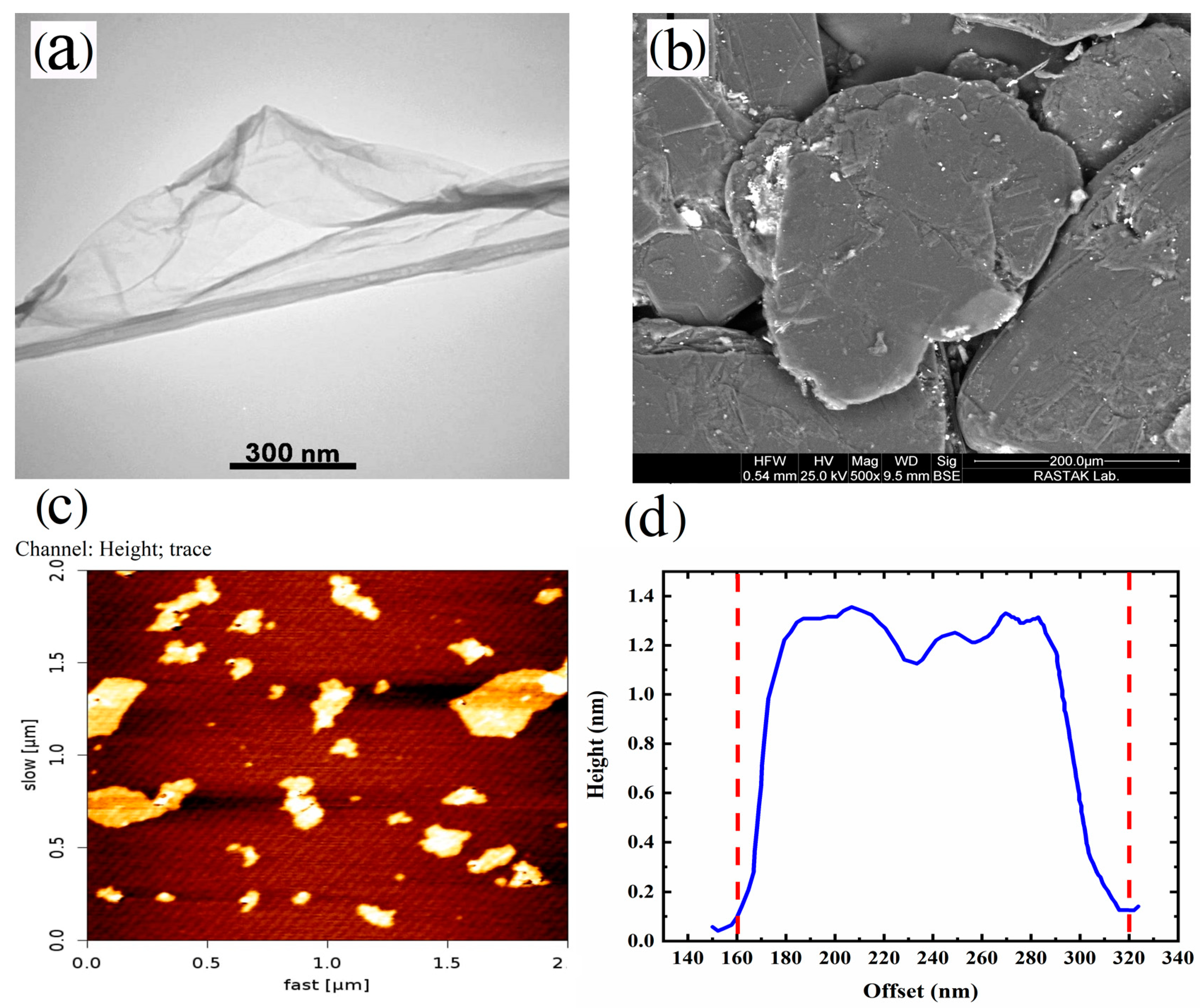

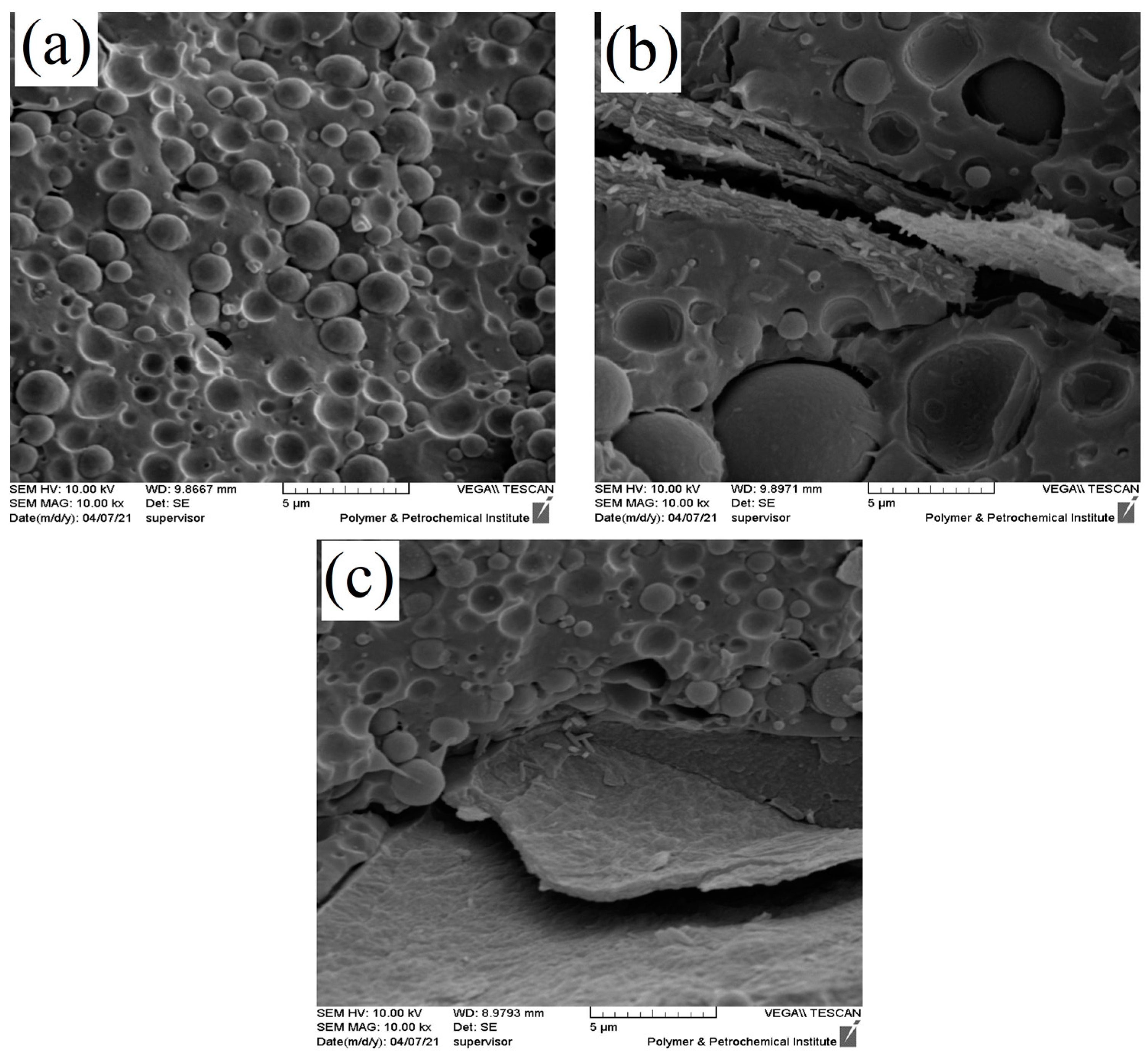


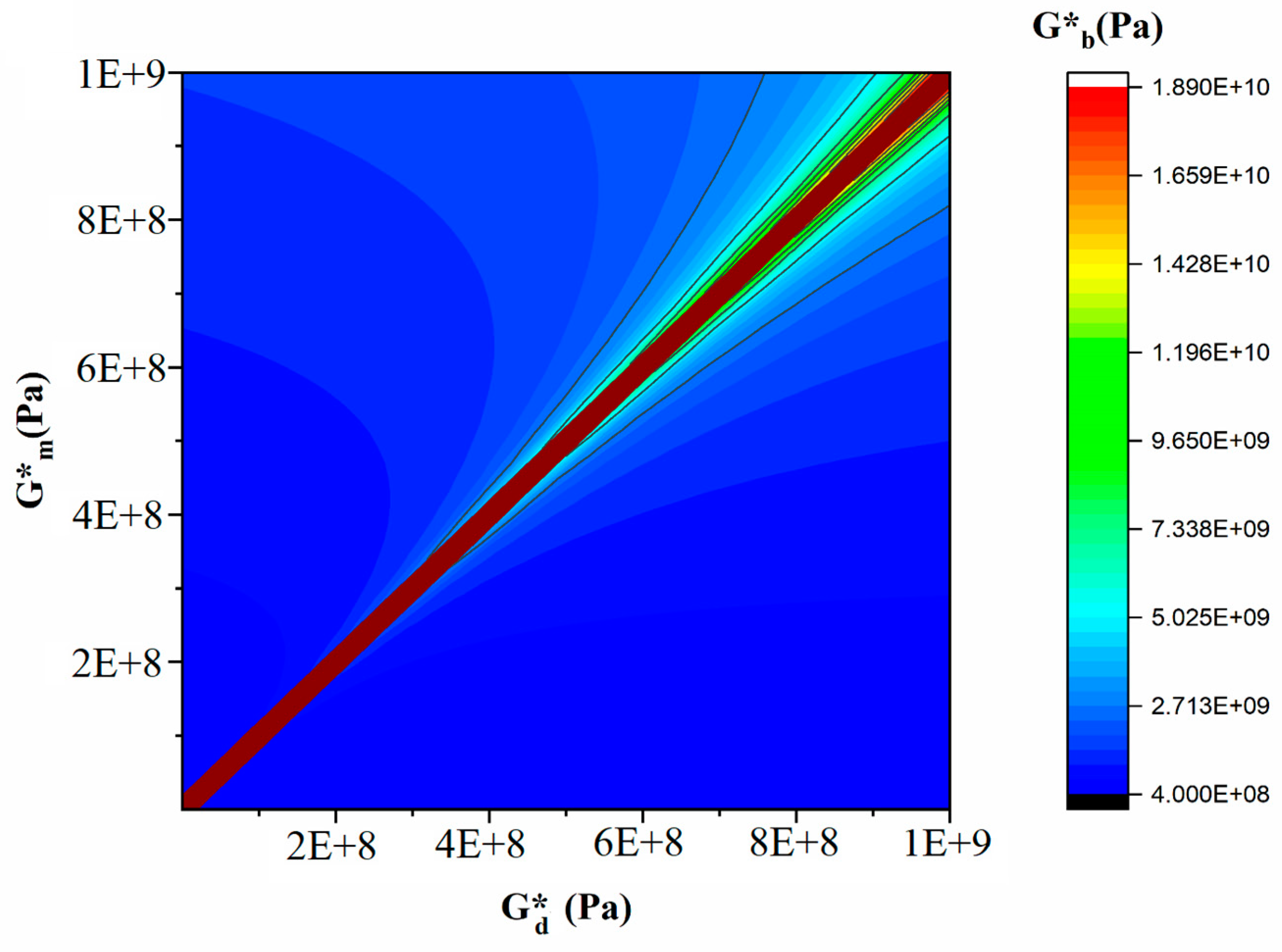
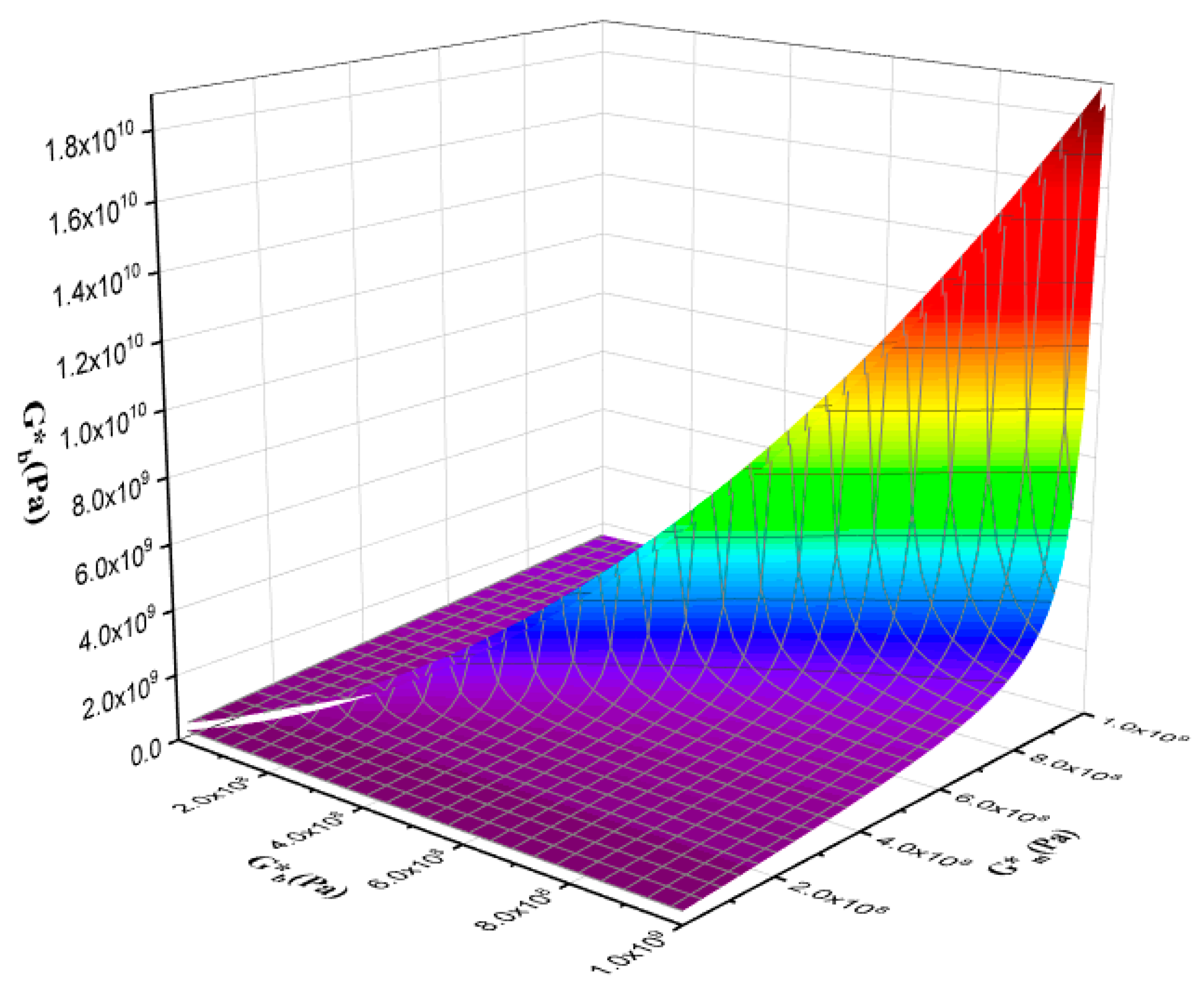

| Code | PLA (wt.%) | EVOH (wt%) | GO (wt%) | Protocol of Mixing |
|---|---|---|---|---|
| PLA/EVOH | 70 | 30 | 0 | M |
| (PLA/EVOH)/1GO | 70 | 30 | 1 | M |
| (PLA/EVOH)/0.5GO | 70 | 30 | 0.5 | M |
| (PLA/EVOH)/0.25GO | 70 | 30 | 0.25 | M |
| (EVOH/0.25GO)/PLA | 70 | 30 | 0.25 | N |
| (PLA/0.25GO)/EVOH | 70 | 30 | 0.25 | O |
| Sample | γd | γp | γs | Reference |
|---|---|---|---|---|
| PLA | 25.1 | 6.6 | 31.8 | [38] |
| EVOH | 26.4 | 11.6 | 38 | [39] |
| GO | 32.1 | 30 | 62.1 | [40,41] |
| Sample | Code | Interfacial Tension (Harmonic Equation) | Interfacial Tension (Geometric Equation) |
|---|---|---|---|
| PLA/EVOH | γ12 | 1.5 | 0.8 |
| PLA/GO | γS1 | 15.9 | 8.9 |
| EVOH/GO | γS2 | 8.7 | 4.6 |
| ω12 | 4.2 | 5.3 |
| Sample | Rn (µm) | Rv (µm) | Dispersity |
|---|---|---|---|
| PLA/EVOH | 0.81 | 1.01 | 1.24 |
| (PLA/EVOH)/1GO | 1.26 | 2.83 | 2.24 |
| (PLA/EVOH)/0.5GO | 1.47 | 2.84 | 1.93 |
| (PLA/EVOH)/0.25GO | 1.23 | 1.94 | 1.57 |
| (EVOH/0.25GO)/PLA | 1.60 | 3.13 | 1.95 |
| (PLA/0.25GO)/EVOH | 0.80 | 0.94 | 1.18 |
| Sample | Tensile Strength (MPa) | Elongation at Break (%) | Modulus (MPa) |
|---|---|---|---|
| PLA/EVOH | 27.8 ± 0.1 | 2.02 ± 0.02 | 1298 ± 31 |
| (PLA/EVOH)/1GO | 44.2 ± 0.05 | 3.45 ± 0.1 | 1540 ± 103 |
| (PLA/EVOH)/0.5GO | 38.2 ± 0.3 | 2.94 ± 0.05 | 1504 ± 98 |
| (PLA/EVOH)/0.25GO | 33.8 ± 0.4 | 3.00 ± 0.01 | 1293 ± 21 |
| (EVOH/0.25GO)/PLA | 27.4 ± 0.4 | 2.55 ± 0.07 | 1078 ± 34 |
| (PLA/0.25GO)/EVOH | 34.6 ± 0.4 | 3.47 ± 0.06 | 1444 ± 78 |
Disclaimer/Publisher’s Note: The statements, opinions and data contained in all publications are solely those of the individual author(s) and contributor(s) and not of MDPI and/or the editor(s). MDPI and/or the editor(s) disclaim responsibility for any injury to people or property resulting from any ideas, methods, instructions or products referred to in the content. |
© 2024 by the authors. Licensee MDPI, Basel, Switzerland. This article is an open access article distributed under the terms and conditions of the Creative Commons Attribution (CC BY) license (https://creativecommons.org/licenses/by/4.0/).
Share and Cite
Dadashi, P.; Ray, S.S.; Babaei, A. Effect of Graphene Oxide Localization on Morphology Development and Rheological and Mechanical Properties of Poly(lactic acid)/ethylene vinyl Alcohol Copolymer Blend Composites: A Comprehensive Study. Polymers 2024, 16, 1061. https://doi.org/10.3390/polym16081061
Dadashi P, Ray SS, Babaei A. Effect of Graphene Oxide Localization on Morphology Development and Rheological and Mechanical Properties of Poly(lactic acid)/ethylene vinyl Alcohol Copolymer Blend Composites: A Comprehensive Study. Polymers. 2024; 16(8):1061. https://doi.org/10.3390/polym16081061
Chicago/Turabian StyleDadashi, Parsa, Suprakas Sinha Ray, and Amir Babaei. 2024. "Effect of Graphene Oxide Localization on Morphology Development and Rheological and Mechanical Properties of Poly(lactic acid)/ethylene vinyl Alcohol Copolymer Blend Composites: A Comprehensive Study" Polymers 16, no. 8: 1061. https://doi.org/10.3390/polym16081061





